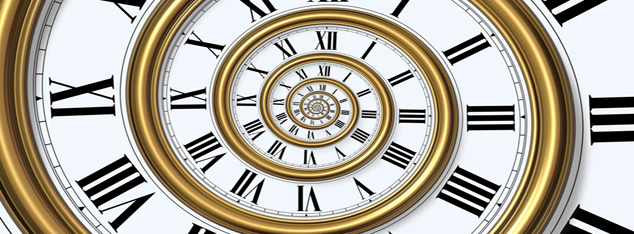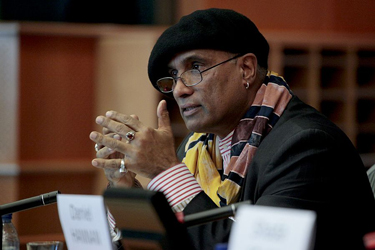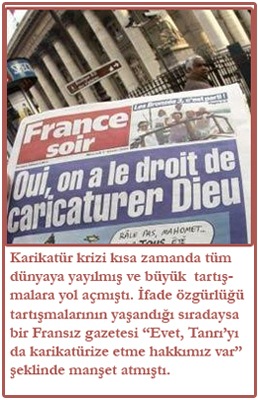The fasting month, in spite of its private nature (‘Fasting is Mine’,
as the hadith insists), is more of a public affair than any of the other
rites of religion, perhaps because of its elemental quality; and in
this city it forces each citizen to decide how he stands with God.
Ramadan brings to the surface some of Istanbul’s deepest human secrets.
The great City resembles the improbable arm of the sea that cuts it in
half, cheerfully consistent on the surface, yet churned by strange
currents known only to veteran fishermen. The fasting month, in spite of
its private nature (‘Fasting is Mine’, as the hadith insists), is more
of a public affair than any of the other rites of religion, perhaps
because of its elemental quality; and in this city it forces each
citizen to decide how he stands with God. No-one is surprised to see the
men in green caps crouched behind the wheels of their old Shahins,
weaving through the traffic ten minutes before sundown. More interesting
are the fashionable young men with pigtails and goatees (the current
fad), discreetly accepting glasses of tea as the adhan divides
the City into the grateful and the guilty. The first useful lesson that
Istanbul provides is never to judge by appearances.
The
adhan rolls out from a thousand minarets; and foodstalls and
borek
parlours that have been sleepy all day, catering only for the odd
tourist or religious cynic, suddenly spring into life. God seems to have
thrown a giant switch, and the whole city is galvanized. Many
Stambullus have been waiting at restaurant tables for an hour before
sundown, and those who are still milling in the streets will now have to
struggle to find a hot meal. This is the picture even in the chic
Westernised suburbs of Kadiköy, Beyoglu and Sisli; while near the great
mosques, their minarets beacons which summon huge crowds, fairs are now
doing brisk business. Around the great mosque-complex of Sultanahmet,
hundreds of street vendors, many defying the prohibition on non-Western
dress, call out the virtues of their candyfloss, sweetcorn, roast
chestnuts, pastries, buttermilk, lindenflower tea, and spiced sausages.
The aroma of tripe soup and tobacco mingles with religious songs by
Gunesdogdu, Bahriyeli and Ozer. Children gape at street performers (the
fortune-teller with his baby rabbits; the shadow-puppet man, the legless
beggar on wheels).
By the western gate of the Sultanahmet Mosque a man dressed in a Goofy
suit suddenly appears, followed by a camera crew. This is Doggy, chief
attraction of a children’s show on Hilal TV, one of Turkey’s fifteen
religious channels. Doggy has come to Sultanahmet, it seems, to ask
small children how old they are. The smallest are aghast, as well they
might be; but the older ones are quite familiar with Doggy. They talk
firmly into the microphone, giving their names and ages, and talking
about what they like best about Ramadan. Back in the studio, later on,
Doggy will bow his head as a child member of his studio audience recites
a poem about the Prophet’s poverty. The camera zooms in on the face of a
little girl, who is about to cry.
Out of place in this crowd are the tourists. Jollity forms no part of
their understanding of Islam; and this happy yet entirely non-alcoholic
street party seems to worry them. Once, in the days of romance-hunters
like Nerval and Pierre Loti, the difference of the
foule Orientale
allowed Europeans an Olympian detachment, as they contemplated ‘Turkish
customs’ as a raree-show of curious menagerie performances. Now,
however, as the Turks’ clothes and body language have been Westernised –
indeed, as young Turks look more fashionable than the tourists
themselves - the difference of ‘Oriental’ from ‘European’ has been
largely abolished. This new City is more challenging because less
strange, and many visitors seem to respond with a grim determination to
hold their breath, rather than to inhale the air which animates these
happy crowds.

Some spectacular examples of this are readily found. Tourist women who
are asked not to enter mosques or graveyards with their thighs exposed
behave like righteous martyrs, their faces indicating all the contempt
which the enlightened West will muster in the face of benighted
prudishness. And once, at the Beyazit mosque, I saw a group of German
men enter the mosque during the prayer. Walking up and down the rows of
worshippers, they scanned their camcorders over the faces of these
picturesque Turks. When the prayer was over, the Turks called the
tourist police, who no doubt explained politely that the sensibilities
of worshippers should be respected. I suspect that the proud Teutons,
coming from a country where Muslims have to pay a tax to support the
national churches, may not have understood the nature of their offence.
High above the throng, suspended between two of the six minarets, is a mahya,
a pattern of lightbulbs whose message is changed every couple of days.
Today it is ‘TOGETHERNESS IS A MERCY.’ In Ottoman times, the mahyaci, or
master-craftsman responsible for designing and hoisting these messages,
was a public celebrity.
What the tourists at Sultanahmet really resent, of course, is not the
existence of smiling Turks, but the fact that all this joy seems
connected to the vast shadow of the imperial mosque which looms behind
the fair. High above the throng, suspended between two of the six
minarets, is a
mahya, a pattern of lightbulbs whose message is
changed every couple of days. Today it is ‘TOGETHERNESS IS A MERCY.’ In
Ottoman times, the mahyaci, or master-craftsman responsible for
designing and hoisting these messages, was a public celebrity. He would
embroider coloured designs on pieces of satin, which he would present to
the sultan, who would then choose the designs and phrases which would
appear on the great imperial mosques. On occasion the mahyaci would
present moving images, such as boats and fish. Abdullatif Efendi
(d.1877), perhaps the most famous of all mahyacis, once presented an
image of a royal barge suspended between the Süleymaniye’s minarets, on
the night of the 15th of Ramadan. Pictures are now no longer seen, and
in the early Republican period there was a vogue for national messages,
such as ‘DON’T FORGET THE RED CRESCENT,’ ‘BUY LOCAL GOODS’, and
‘REMEMBER AIRCRAFT’; but today the slogans are purely religious once
more.
Those who enter the courtyard during Ramadan will find an enormous
bookfair, where sixty of the country’s leading religious publishers
offer their newest works. In recent years, the older type of literature,
such as poorly-printed prayer-books with garish covers, or manuals for
housewives, has receded, in favour of a new, sophisticated body of
writing. Publishers like Iz and Gelenek have no equivalent elsewhere in
the Islamic world, bringing out works of interest by non-Muslim
philosophers, as well as modern Muslim thinkers. The focus is on Western
Muslim writers: Garaudy, Winkel, Valsan, Herlihy, Eaton and others; and
Middle Eastern texts, apart from classical ones, are scarce. It is all
rather intellectual, and even elitist; although populism is still
present, and there are several concessions to the local love of
conspiracy theories: ‘ATATURK THE BULGARIAN’ (banned); ‘ROBIN COOK
POISONED BY MOSSAD FOR OPPOSING THE IRAQ WAR’ (fairly popular); ‘BIN
LADEN THE PENTAGON’S PAWN: THE HIDDEN STORY’ (circulation unknown).
The Blue Mosque, despite its immensity, is full for Tarawih prayers;
and this is not terribly surprising, given the beauty of the ceremony
here.
The Blue Mosque, despite its immensity, is full for Tarawih prayers;
and this is not terribly surprising, given the beauty of the ceremony
here. In some mosques, the full
khatm is observed; but here the
Tarawih lasts for less than an hour, after which the crowds rejoin the
fun of the fair. After each four rak’as a brief interval of collective
dhikr supervenes, in the form of the
salat-i ummiyye;
and at the end there comes a prayer which, booming around the
vastnesses of the mosque, recalls the superb rolling dignity of the
Ottoman language. As Urdu-speakers well know, prayers in a language
where everything happens before the verb have tremendous dramatic
impact: ‘And our sins, in this and earlier months, against You and other
members of our nation, Our Lord, forgive! And the affairs of the
Muslims here and in the world, Our Lord, set right! And to the soul of
Sultan Ahmet, Our Lord, grant rest!’
In the Ottoman period, the great singers faced their greatest audiences
during Ramadan worship; and in recent years attempts have been made to
revive the symphonic quality of the Tarawih of days gone by. Knowledge
of the
maqam system is axiomatic here. Some younger, less
qualified men with soaring voices are allowed to recite in the mosques
during Ramadan, even when the ritual is televised live; but in theory
only those with an
ijaza in
maqams can be heard. Hence the
ilahi singer in the Fatih mosque, who sings a special Ramadan
qasida or a
ghazal after each four
rak’as, may set the artistic pace for the entire ceremony. The Istanbul
adhan and
iqama are often in
maqam Hijaz or Saba, but the
yatsi prayer itself is typically in Rast, the critical musical moment being the connection between the final words of the
iqama and the imam’s
takbir.
This produces a contrast, which is then articulated by the muezzin in
the ceremonial words which gather the congregation for the Tarawih, with
its twenty formal
rak’as. These often begin, as
tajwid conventionally does, in
maqam saba,
but after four rak’as the singer will modulate into one of the modes
which may permissibly follow from Saba: Kurd, Nahawand, or Ushshak. The
imam of the mosque will then begin the fifth
rak’a in the same
maqam,
beginning an exquisite modal dialogue which congnoscenti hope, usually
with good reason, will descend at the right pace back to
saba during the
Witr. Six
maqams
may thus be heard during the single Tarawih. Kani Karaca, the blind,
aged chief muezzin of the Süleymaniye mosque, who died only recently,
was certainly capable of many more, firing his voice high into the
sublime, shadowy spaces of Sinan’s greatest masterpiece.

Following the collapse of the Ottoman Empire, musical standards in the
great metropolitan mosques started to decline. At the Süleymaniye,
however, largely thanks to a musically sophisticated partnership between
Imam Muzaffer Ozak (d.1985), and the chief muezzin, Hafiz Sevket
Efendi, which lasted for twenty-six years, the old traditions were
faithfully preserved. One of Ozak’s pupils, the singer Ahmet Ozhan, who
abandoned pop culture in favour of religious music, is working hard to
maintain the transmission of this precious heritage. The
founder-director of the Turkish Historical Music Society, Ozhan strives
to spread knowledge of the traditional Rajab and Sha’ban songs, of the
different ilahi hymns appropriate at different points in Ramadan, and
the right style of leading Tarawih. A household name in Turkey, Ozhan’s
efforts have already transformed the quality of religious music in many
of the country’s mosques.
The high artistic standards of the Istanbul Ramadan have done much to
hold the attention of the Turkish population. Some entirely secular
souls will come to hear the Tarawih as they might attend the opera; and
many have found God as a result.
The high artistic standards of the Istanbul Ramadan have done much to
hold the attention of the Turkish population. Some entirely secular
souls will come to hear the Tarawih as they might attend the opera; and
many have found God as a result.The crowds are vast, quickly filling the
immensity of the mosques. But on the 27th of Ramadan, which the Mufti
decrees is the most probable date of Laylat al-Qadr, the crowds and the
imams shift into a still higher gear. Sabah prayer at the mosque of Eyüp
is the most popular worship experience in the city; but arrive even at
two in the morning on the 27th, and you will find it hard to squeeze
beyond the leather curtains into the mosque interior. Here, more than
anywhere else in the City, the Turks are feasting, and feasting again,
on the Qur’an.
Like a benign watchful presence, behind the five-hundred year old plane
tree planted by the Conqueror’s own hand in the mosque court, lies the
grave of the Companion Abu Ayyub al-Ansari, which, of the hundreds of
active pilgrimage sites in the City, remains the greatest magnet for
visitors.
Like a benign watchful presence, behind the five-hundred year old plane
tree planted by the Conqueror’s own hand in the mosque court, lies the
grave of the Companion Abu Ayyub al-Ansari, which, of the hundreds of
active pilgrimage sites in the City, remains the greatest magnet for
visitors. The space is ablaze with a turquoise glow, supplied by the
Iznik tiles, which are among the most precious ceramic masterpieces in
the world. Close beside it is the I‘tikaf chamber built for Princess
Adile, who spent her Ramadans here a century ago, before being buried
among the royal tombs nearby. Outside lie the graves of warlike pashas,
sayyids, and ulema, including Ebussuud Efendi, the great
tafsir
scholar, and reviver of the Shari‘a in the time of Sultan Suleyman.
Here too are the sainted ladies, and then great madrasas and tekkes,
beyond the stone stairs where a new Sultan, visiting the mosque for his
coronation, would descend from his horse, to walk the remainder of
Enthronement Road humbly on foot. In his palace, the Sultan alone could
ride; at Eyüp, he too was required to dismount.
Other holy places abound in the City, and have played their part in
keeping the Turkish spirit alive. Take the ferry, for instance, from
Seraglio Point to the Asian suburb of Üsküdar, and you will find the
tomb-complex of Aziz Mahmud Huda’i alive with visitors from every social
background (this is the suburb where wealthier religious people live).
Higher up the hill is the tekke of his pupil Selami Baba, whose mineral
waters are still popular, and where the cemetery contains fallen heroes
of Turkey’s wars. As the ship approaches the shore, one reads ‘ISLAM IS
GOOD MANNERS’ in the sky-writing between the minarets of the mosque of
Princess Mihrimah, daughter of Suleyman and in her day the richest woman
in the world, and whose mosque and
madrasa are among the
climaxes of the City’s architecture. Moored nearby is the ‘Ramadan
Ship’, a smart passenger vessel chartered by the Üsküdar municipality,
where one may break one’s fast, and be regaled with religious music
while contemplating the incomparable skyline of the European shore.

The increasing presence of women in the mosques is posing some
interesting problems. Sinan and his colleagues were Hanafis, and gave
little thought to the accommodation of worshipping women. Today,
however, ever-larger numbers of women come to the mosques, and this is
particularly evident during Ramadan. For the Sultanahmet Tarawih,
therefore, large areas in the main prayer-hall have been allocated to
women. In the confined space of the Noble Mantle Mosque, however, this
is impossible, so the neighbouring mosque of Hoca Uveis has been
designated a women-only prayer hall during the congregational prayers,
particularly at the Ogle and Ikindi prayers, when most visitors come.
This process seems set to continue. Most theology students in Turkey now
are women, and the country appointed, in 2005, its first female muftis.
There are also over six hundred full-time female preachers (
vaize).
Laylat al-Qadr is followed by another change in mood. The sky-writing
at Sultanahmet now reads: ‘INTERCEDE O MESSENGER OF GOD!’ Most poignant
is the Arefa Day, the last day before the Bayram
Laylat al-Qadr is followed by another change in mood. The sky-writing
at Sultanahmet now reads: ‘INTERCEDE O MESSENGER OF GOD!’ Most poignant
is the Arefa Day, the last day before the Bayram (its name is a curious
borrowing from the fasting day before the Great Bayram). The television
stations are alert to the bitter-sweet quality of this time, especially
as the
adhan for
aksam prayer approaches. The team of
men in suits who have been sitting in a boat in the Bosphorus every
afternoon in Ramadan, talking about Religion and Life, are now
discussing forgiveness. A live broadcast from the Eyüp mosque shows the
mufti of Kayseri ending the fast with a long prayer. Even the commercial
breaks are few. (MUMMY, I WANT A HITTITE BISCUIT. GIVE ME A HITTITE
BISCUIT PLEASE. HAYIR GAS: BECAUSE YOUR LIFE IS PRECIOUS TO US. BELLONA
FURNITURE: HOW HAPPY AM I TO HAVE FOUND IT.)
Next day, the fast ends with the Lesser Bayram. Unless one is attracted
to the prospect of an hour shivering beneath the October rain, it is
wise to set out for the mosque shortly after Sabah prayers, or even to
stay in the mosque from Sabah until the Bayram Imam appears in
splendour, an hour after sunrise. So I leave my house in Stygian
darkness and walk through the silent streets of my ghetto district. The
graffiti is just visible: PEST CONTROL CALL 538 244 7622. DOWN WITH
FENERBAHCE. HE WHO LOVES ALLAH WILL NOT THROW HIS RUBBISH HERE. More
decorously, high above the street, competing politicians wish us well.
MAY YOUR BAYRAM BE BLESSED AND PROSPEROUS. (SALVATION PARTY). WE WISH
YOU A MERRY BAYRAM. (REPUBLICAN PEOPLE’S PARTY). MAY YOU AND YOUR
FAMILIES AND ALL OUR COUNTRY ENJOY A PEACEFUL AND PROFITABLE BAYRAM. (AK
PARTY.)
Inside the mosque of Sultan Beyazit, popular with Sufi pietists as a
mosque built only with entirely lawful funds, there is still room for
me. In the
mihrab, a hoca is giving us Surat al-Rahman in a local
hadr style. The
qafla
is crisp, and the quarter-tones immaculate. This is good news, since we
still have an hour to go. I notice that after every minute or so, the
hoca pauses, while everyone in the mosque recites the Bayram
takbir. He then reads a translation of his text. This audience participation means that the hoca’s voice must remain in a single
maqam
for an hour, and this he manages, in an austere performance that is
entirely in keeping with the atmosphere of this restrained and ascetical
building.
The Bayram Imam appears, and the men near the
mihrab rise in respect. He reminds the congregation of the Hanafi traditions of the Bayram
namaz, and then the great crowd is hushed in prayer. After the
teslim,
he ascends the minbar, one step at a time, until, after almost a
minute, he is three steps from the summit. Here he bows briefly to the
qibla,
hand on heart, and then turns, to allow the voice of religion to fill
the mosque, as it has done for a thousand Bayrams before. He speaks of
the need to maintain the momentum of Ramadan, and not to leave
compassion and worship behind as we travel onwards from the month.
After the
khutba, in the courtyard of the mosque, many in the crowd have formed a circle beneath the colonnade. To the sound of the
salat-i ummiyye,
everyone moves around the circle, embracing everyone, until, reaching
its end, they stand in their turn. The procedure takes a long time; but
it is voluntary, so I find a side exit, and re-enter the now busy
streets. Shops are closed, but buses and trams are free for the three
days of the holiday, and many Stambullus are already beginning the round
of visits to friends and relations which lie at the heart of this
family festival.
That evening, high above the eastern minarets of Sultanahmet, the sky writing reads
Elveda: Farewell.

 Avrupa Irkçılıkla Mücadele Kurumu Başkanı Baishy Quraishy
Danimarka'da başlayan karikatür krizi süreci ve Avrupa'da artan İslam
karşıtı hareketler hakkındaki sorularımızı yanıtladı. Günümüzün önemli
aktivistlerinden olan Quraishy, karikatürlerin yayımlanmasıyla başlayan
süreçte yaşananların birden ortaya çıkmadığı ve bunun planlanmış bir
provokasyon olduğu görüşünü vurguladı.
Avrupa Irkçılıkla Mücadele Kurumu Başkanı Baishy Quraishy
Danimarka'da başlayan karikatür krizi süreci ve Avrupa'da artan İslam
karşıtı hareketler hakkındaki sorularımızı yanıtladı. Günümüzün önemli
aktivistlerinden olan Quraishy, karikatürlerin yayımlanmasıyla başlayan
süreçte yaşananların birden ortaya çıkmadığı ve bunun planlanmış bir
provokasyon olduğu görüşünü vurguladı.  İFADE ÖZGÜRLÜĞÜ BÜYÜK BİR YALAN
İFADE ÖZGÜRLÜĞÜ BÜYÜK BİR YALAN
 angi
kitapları okuduğu, nelere güldüğü ve hangi tür müzik dinlediği, bir
insanın karakterine dair ipuçları verirmiş. Belki bu üçlünün son iki
tanesi bir insanın ahlâkî seviyesini de göstermesi açısından son derece
mühimdir.
angi
kitapları okuduğu, nelere güldüğü ve hangi tür müzik dinlediği, bir
insanın karakterine dair ipuçları verirmiş. Belki bu üçlünün son iki
tanesi bir insanın ahlâkî seviyesini de göstermesi açısından son derece
mühimdir.




